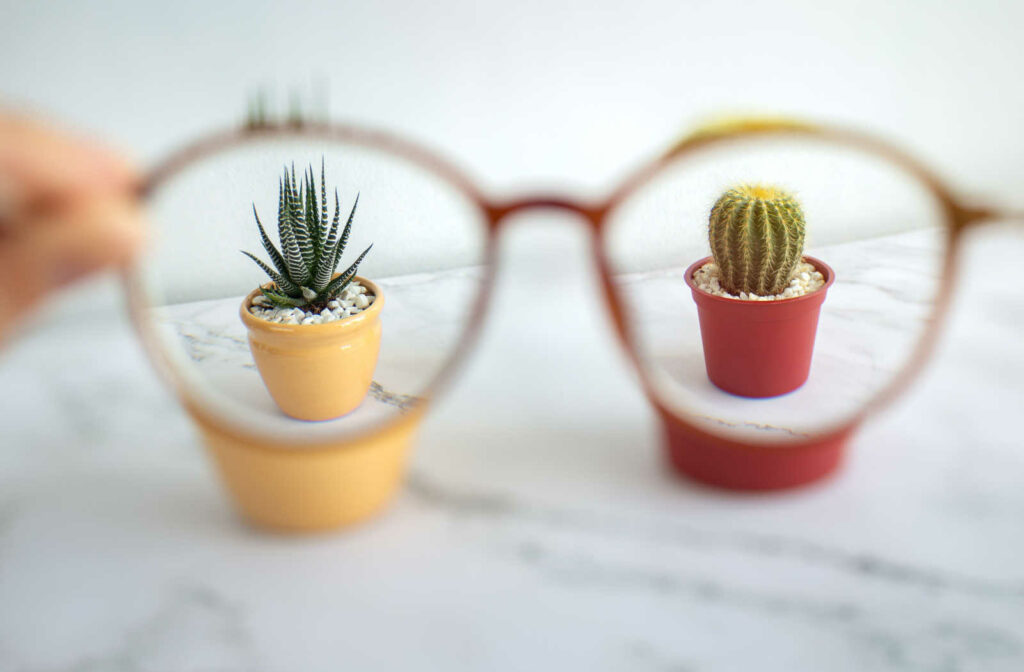The prevalence of myopia (nearsightedness) is increasing in the United States and globally. Fortunately, it can be detected early through children’s eye exams. Myopia can continue to get worse as kids grow, but early detection makes it possible to slow the progression of myopia and preserve your child’s long-term eye health with myopia management.
Myopia tends to worsen over time as children grow because their eyes continue to get longer. Myopia management techniques are based on signaling the eye to stop or slow its growth, helping your child’s vision remain consistent as they grow.
Learning more about myopia and your options for helping your child manage its effects can help you make the right decision for protecting your child’s vision.
What Is Myopia?
Myopia is a refractive error that develops when the eyeball is longer than it should be or the cornea is too curved. When that happens, light entering the eye doesn’t focus on the retina, leading to blurry distance vision.
Myopia typically first appears between the ages of 6 and 14, but kids’ eyes can continue to grow until around age 20. For this reason, many school-aged children with myopia experience worsening vision as they get older.
Symptoms of Myopia
Kids aren’t always able to tell their parents that something is wrong with their vision, or they might not realize there’s a problem—especially when they are young. A few signs of nearsightedness that you can look for include:
- Frequent headaches and eye strain
- Eye rubbing
- Sensitivity to light
- Trouble seeing the whiteboard at school unless sitting at the front of the classroom
- Sitting too close to the TV or computer screen
- Persistent squinting
- Holding objects or books close to see properly
- Short attention spans
Risk Factors for Myopia Development
There is a genetic component to myopia. When 1 or both parents have myopia, kids are often at an increased risk of developing myopia themselves. However, apart from genetics, there are a few additional factors that can increase kids’ risk of developing myopia.
Lack of Time Spent Outdoors
There is evidence that outdoor play with exposure to natural light can decrease children’s risk of developing myopia. This may be because spending time outdoors helps the eyes focus on objects at a distance, giving the eye muscles a chance to relax from constant near focus.
There is also a suggestion that the retina releases dopamine in response to bright sunlight, and the increased dopamine may inhibit axial elongation of the eyeball.
Near Vision Activities
Near vision tasks and activities include anything that requires you to focus close-up. There has been continued research into the idea that activities like reading, writing, using a phone, or working on a computer can increase a child’s risk of developing myopia.
Studies are also being conducted about the association between increased screen time and myopia. Some of these studies suggest that prolonged screen time from digital devices such as computers, tablets, and phones may increase the risk of developing myopia or lead to myopia progression by putting stress on the eyes.

How Is Myopia Treated & Managed?
The most common corrective measures for myopia are glasses and contact lenses. However, standard glasses and contact lenses are not designed to stop myopia from getting worse—they only correct vision.
Myopia management is a form of eye care based on using specialty contacts and other treatments to help slow or stop the growth of kids’ eyes. Addressing that underlying cause of myopia progression is important for helping kids avoid the potential complications of high myopia.
Myopia management also helps keep kids’ prescriptions stable, which can reduce the need for new glasses and contact lenses as kids get older.
Low-Dose Atropine Drops
Low-dose atropine eye drops can slow myopia progression. Most practitioners will use atropine eye drops in combination with other treatments.
Ortho-K (Orthokeratology)
Orthokeratology involves wearing rigid, gas-permeable contact lenses overnight. The lenses gradually reshape the eyes as kids sleep. The effects can slow the progression of myopia and help kids see clearly during the day without the need to wear daytime glasses or contact lenses.
Ortho-k contact lenses can be an excellent option for kids who don’t want to wear contact lenses or glasses—especially active children and swimmers.
Multifocal Contacts
Multifocal contact lenses are designed with multiple rings that have different prescription strengths. These soft contact lenses can signal your child’s eyes to stop elongating by changing the way light focuses.
How to Reduce Your Child’s Myopia Risk
While factors such as a family history of myopia or age are out of your control, there are some things we can control. Here are a few tips that may help reduce your child’s risk of developing myopia:
- Encourage outdoor play as much as possible, at least 1 hour per day.
- Avoid screens for children 4 years and younger.
- Limit screen time in young children to 1 hour for ages 4–6 and 2 hours for ages 7 and older.
- Encourage children to take breaks between screen time and when doing near-focus activities.
Let’s Prevent Myopia Progression
It’s critical to have your child’s eyes checked every 6 months if they have myopia. This helps us confirm that their eyes have not elongated and their myopia remains stable. If their eyes have grown longer, we can take early steps to help manage their growth with myopia control.
If you suspect your child has a vision issue or you have noticed the tell-tale signs of myopia, book an appointment with Specialty Eye today. Together, we can help your child enjoy stability in their vision and eye health.




